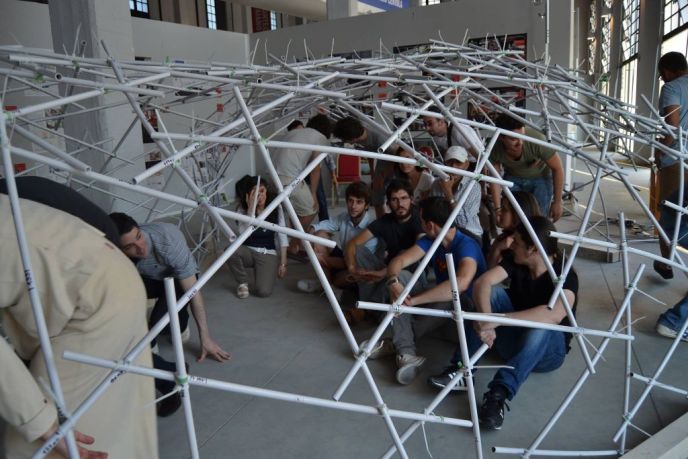This four day workshop was held in Salerno in September 2013 with Daniel Piker and Gennaro Senatore as tutors. The goal was to design and build a reciprocal frame system from a freeform surface, helped by the new kangaroo tools Daniel was developing. You can have an idea of what a reciprocal frame system is reading my article on Nexorade, bear in mind that traditionally these structure were conceived to work only with compression shear forces, but negative curved surfaces inevitably bring to traction shear forces, that’s why it was necessary to use plastic strings to keep the assembly together.

You can download the Grasshopper definition and the output file here.
Day 1
The two tutors introduced themselves and we did the same. The team was composed by people who already knew Grasshopper but for others it was the first time. The tutors introduced the software and what probably is its most renowned plugin Kangaroo, which we would have extensively used.
Day 2
Daniel explained how to use Kangaroo to form find membranes in in pure tension and asked to produce a nice surface compliant with the space where the pavilion would have been put. That surface would then have been used as a base for the reciprocal system.
We started from a triangular mesh, since that’s the arrangement we wanted for the reciprocal system. The boundaries where fixed, whilst the inner ones where used as springs with rest length equal to the initial one. A uniform upward load was applied, so that the actual structure would have resisted vertical (gravity) loads. To produce a good surface it’s helpful to use a clean mesh possibly close to the final shape, in fact during relaxation each spring produces a force proportional with its deformation. The best would be to iteratively relax a mesh and then use it as starting mesh, until all the members elongates to the same amount.
The mesh was then refined using Picker’s remeshing tool which takes advantage of Plankton which brings the Half-Edge data structure into Grasshopper. We ended up having a neat triangular mesh, ready to be transformed into a reciprocal system!
Day 3
The reciprocal system was found using Kangaroo’s component, checking that the resulting structure would stand without the members sliding one over each other. The processed followed until now bought to a structure which worked in pure axial force and shear, with no additional bending. That being done, before fabrication we had to number each stick and to know which and where other sticks crossed the former. This was done creating a grasshopper definition.
Day 4
We built it! We started by numbering each plastic tube (they were all the same) writing in the middle its number and on its edges a line showing where the other two would connect and what were their number. The sticks were fixed using rubbers so they won’t have slid and plastic strings.